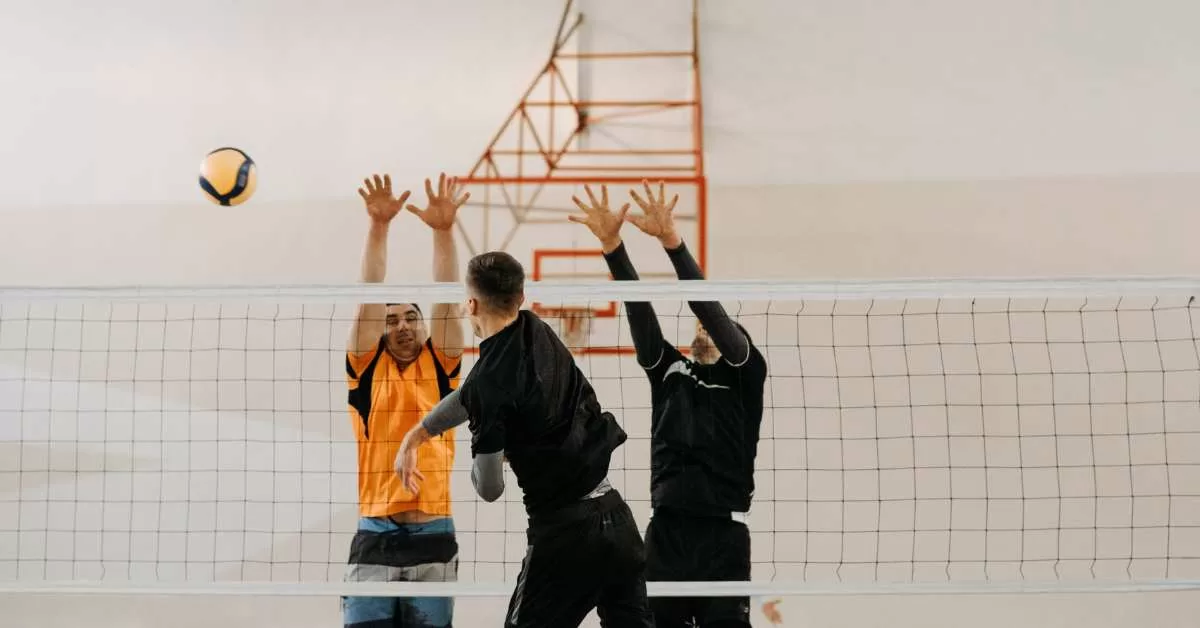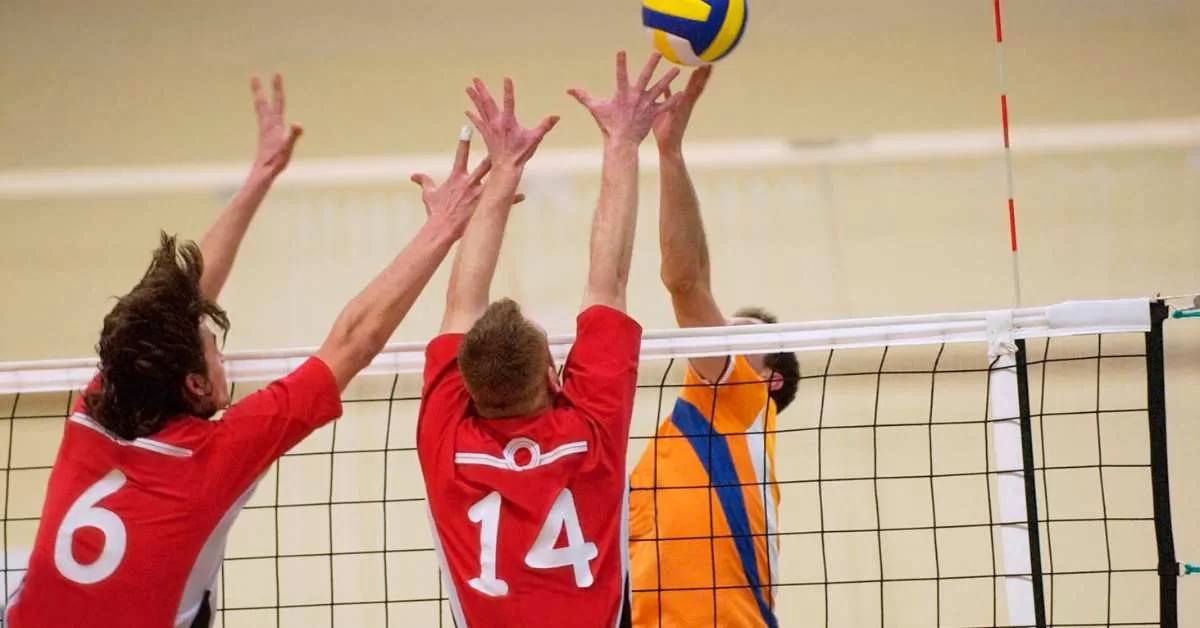Being a setter in volleyball is like being the team’s playmaker. Their main job is to set up the ball for their teammates to hit it over the net. Imagine them as the quarterbacks on the volleyball court.
Every decision they make can make or break a scoring opportunity. They have to be smart and pay attention to which teammate is in the best position to score. It’s a tough job that needs a lot of focus and leadership.
Volleyball Setter Tips: To excel as a volleyball setter, focus on precision and leadership. Make smart decisions, set up teammates for successful hits, and be a reliable playmaker on the court.
Setters are like the conductors of the team’s music, making sure everything runs smoothly and helping the team score points.
Volleyball Setter Tips: Step-by-Step
Here’s a step-by-step guide to volleyball setters:

1. Prioritizing Defense
While a setter’s main role is setting up the attack, it’s important not to rush to offense. Some setters make the mistake of leaving their defensive position too early.
Coaches value disciplined setters who wait until it’s certain the ball won’t come to them before transitioning to offense. Avoid making this common defensive mistake!
2. Spotting Vulnerable Rotations and Preferred Opponents
As a setter, your main goal is to help your team score points. If you notice a weak link on the other side, like a short blocker or an inexperienced setter, it’s wise to keep targeting them. Don’t hesitate to go after the opponent’s weakest player.
Each time you set the ball, it’s like a battle above the net. If your opponent is underequipped, use your best weapons to win.
Being a good setter means making strategic choices to score, even if it means setting the same player multiple times in a row. Winning matters more than being unpredictable.
3. As You Improve, Work on Faster Plays
When beginners start playing volleyball, they often use high, slow sets. As you improve, sets become lower and faster. This is effective because it makes it tough for the blocker to defend. Quick sets give your hitter a better chance for a one-on-one attack.
There are three tempos to remember:
- Slow Tempo (High): Common for beginners.
- Medium Tempo (Hut): Moves faster to the outside.
- Fast Tempo (Go): Used by elite players but challenging to master.
If you’re new, wait to set fast. Elite setters do it, but it takes practice. When you get the chance, practice faster sets to improve your game!
4. Use a Heavier Volleyball for Training
If you’re a good setter, using a heavier training volleyball regularly, ideally every day, is a must. These balls are 70% heavier than regular ones, and they’ll help strengthen your arms, hands, and fingers really well.
When you return to using a normal ball, you’ll be able to set farther, more consistently, and for longer. Check out my article on the best-weighted volleyballs for more info on which ones to buy.
You might also want to read my article on strength training specifically for setters.
5. Improve Your Skills at Home with a Target Net

Practicing setting as a volleyball setter at home can be tough without a net for reference. A great solution is to use a setter target net.
It lets you set targets around your home like you would in a game, much better than just hitting the wall.
If you’re serious about improving your skills, getting one of these is a strong recommendation to level up your game!
6. Commit Setter Hand Signals to Memory
As a setter, a big part of your job is telling your hitters which attacks to use. The best way to do this is by using hand signals that show the play you want to set. If you don’t know these signals yet, click the link above to learn them right away!
7. Master the Setter Dump Technique
A setter dump is when the setter surprises the other team by quickly sending the ball over the net instead of setting it for a spiker. To do it well, you need to be sneaky.
Pretend like you’re going to set the ball normally with both hands and only at the last moment, use one hand to send it over the net. Don’t drop your hand too early; it’ll give away the trick.
Also, don’t just tap the ball, jump and push it down like a slam dunk. This way, it’s harder for the other team to defend, and the ball should land close to the 10-foot line, out of their reach.
8. Keep Talking to Your Hitters About Their Plays!
Good setters are the ones who keep telling their hitters what to do, not because they forget, but to show they believe in them. It’s like a quick thumbs-up that boosts confidence. For setters, it also helps keep things organized in their own minds.
9. Protect Your Hitters on the Court
As a setter, your work isn’t finished after you set the ball. Coaches like setters who are ready to help out. You also need to protect your hitter by blocking at the net.
This gives your hitter a safety net to pass the ball over. In volleyball, every position has its job, and as a setter, your role is to be the best for your team.
10. Take Advantage of Slower Middle Blockers with Outside Sets

Good setters are always looking for weaknesses to exploit. If you notice a slow middle blocker on the other team, your setter should be excited.
Some middle blockers, especially at the junior level, move slowly and struggle to coordinate. It becomes clear after a few points.
In this case, let your outside hitters know you’ll set them a lot and aim for the gap in the double block. The slow middle will only be on the court for a short time, so take advantage by targeting them repeatedly.
11. Counter the Current with Your Sets
Counter the current with your sets means the setter sets the ball in the opposite direction from where the play is going. When the pass isn’t in the center, blockers tend to move to one side, anticipating the set.
This shows they expect the ball to go a certain way. By setting against their expectations, you can surprise the blockers and create a good opportunity for your hitter on the wing.
12. Become Skilled at the Setover Move
The setover is like the setter dump, all about tricking the other team. It’s when the setter sends the ball just over the net into an empty spot instead of setting it for a spiker.
It doesn’t need much technique; it’s more about timing. You want to aim it behind or next to the blocker where no one’s standing. Keep it low and fast to challenge the defenders.
It’s mostly about having a feel for it and getting better with experience. Even top setters might not explain it perfectly; it’s something you learn over time, and some players are just really good at it.
13. Execute Clever Combination Volleyball Plays
Combination plays are like tricks to take advantage of the other team’s weaknesses. For example, if their middle blocker is blocking too aggressively in the middle, you can use a play like the X combo.
Your middle player acts as a distraction, while your wing hitter gets a chance to hit the ball without facing a block. You can try different combinations but always have a reason for it.
Don’t make the game more complicated just for fun, even though looking cool is a good enough reason!
14. Feel Free to Change Your Strategy
Sometimes, your usual tactics don’t work. Your best hitters might struggle, and that’s when you should change things. Setters have a few options. You can softly hit the ball over the block to surprise the opponents.
Try aiming for the corners but do it subtly. Don’t be too obvious, or they’ll catch on quickly. You can also try a completely different strategy.
Using hitters from the back row is a smart way to change things and maybe catch the other team off guard.
15. Give the Hottest Player More Sets Than Usual

When one player on your team is doing exceptionally well, keep setting them. Talk to them between points and let them know you’re going to give them the ball a lot. Challenge them to step up.
They won’t get every set, but make it a priority. You want the other team to wonder if you’re serious. If you see the blockers trying to predict and move early, try setting in a different direction to catch them off guard.
16. Boost Your Jump for Stronger Blocking
If you’re a tall setter, it’s a big advantage. You can do more on the court, like blocking and scoring points with setter dumps. But if you’re not so tall, you can make up for it by learning to jump higher.
This will make you a better blocker and a more effective setter. Ultimately, being a better setter means you’re a more valuable player. A 185cm setter who can reach 330cm when blocking is much more valuable than one who can reach only 310cm.
17. Make Your Jump Serve a Powerful Weapon
Having a great serve makes any volleyball player more valuable. A strong jump serve sets setters apart. It’s not just about jumping high; you also need a strong upper body to hit the ball as hard as the spikers. You can find more tips in my article on strength training for setters.
18. Improve Your Composure and Game Face
A top-notch setter should be hard to predict. When the pass is perfect, your opponents shouldn’t know where you’re setting the ball outside, behind, or to the middle. Your technique should keep them guessing until the ball touches your hands.
Inexperienced setters give away their intentions by leaning or moving their hips. Great setters stay neutral and use their wrists to direct the ball.
Even with a tight pass at the net, it should be tough to tell if you’ll do a setter dump or set the ball. Some setters always dump in this situation, but great ones find ways to set well from tight passes.
19. Setting Involves Playing with Numbers
The best way to get better as a setter is to practice setting more often than your competitors. If they’re setting 200 times a week, aim for 400 times. Use a weighted setter ball and carry it with you, practicing whenever you have a moment.
Try to get more touches on the ball in any way you can. This includes setting to hitters regularly, especially for quick attacks.
Find a dedicated hitter and spend extra hours on the court, telling them you’ll set as much as they want. This way, both of you will get more practice than your competition.
20. Stay Calm and Collected
Being a setter can be really tough, and it’s hard to understand the pressure unless you’ve been in that position. The pressure can get heavy, especially when things aren’t going well in an intense game.
If you show that you’re upset, your team might feel the same way. So, as a setter, it’s not just about being physically tough, but mentally tough too.
When things seem out of control, take a deep breath, stay calm, and be a leader for your team.
FAQs About Volleyball Setter Tips
Q1: What skills are crucial for a volleyball setter?
Essential skills include precision in setting, effective communication, and quick decision-making.
Q2: How can I improve my setting technique?
Enhance your setting by using a weighted ball, practicing from different positions, and studying professional setters.
Q3: How can I handle the mental pressure of setting?
Stay composed, use deep breathing, and visualize success to manage the mental aspect. Embrace mistakes as opportunities for growth.
Conclusion:
In conclusion, being a volleyball setter is not just about distributing the ball; it’s about being a strategic playmaker and a dependable leader on the court.
The tips provided here encompass the essential aspects of setting in volleyball, from defensive discipline to exploiting weaknesses in the opponent’s lineup.
Whether it’s perfecting the setter dump, practicing with a target net, or improving your jump serve, these tips aim to elevate your game.
Moreover, maintaining composure under pressure and constantly seeking improvement through rigorous practice are vital traits for any setter.
These guidelines can help setters become valuable assets to their teams and achieve success on the volleyball court.
After reading this detailed article, we hope you have a good understanding of Volleyball Setter Tips. If you have any questions, please don’t hesitate to ask in the comments!
